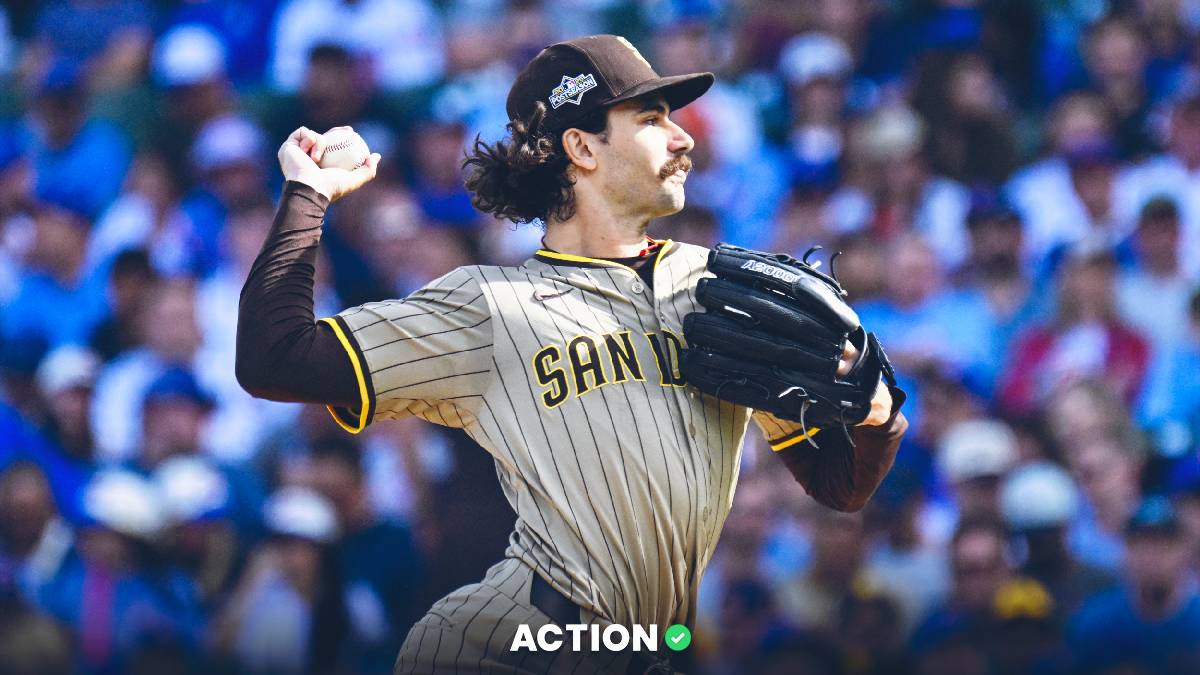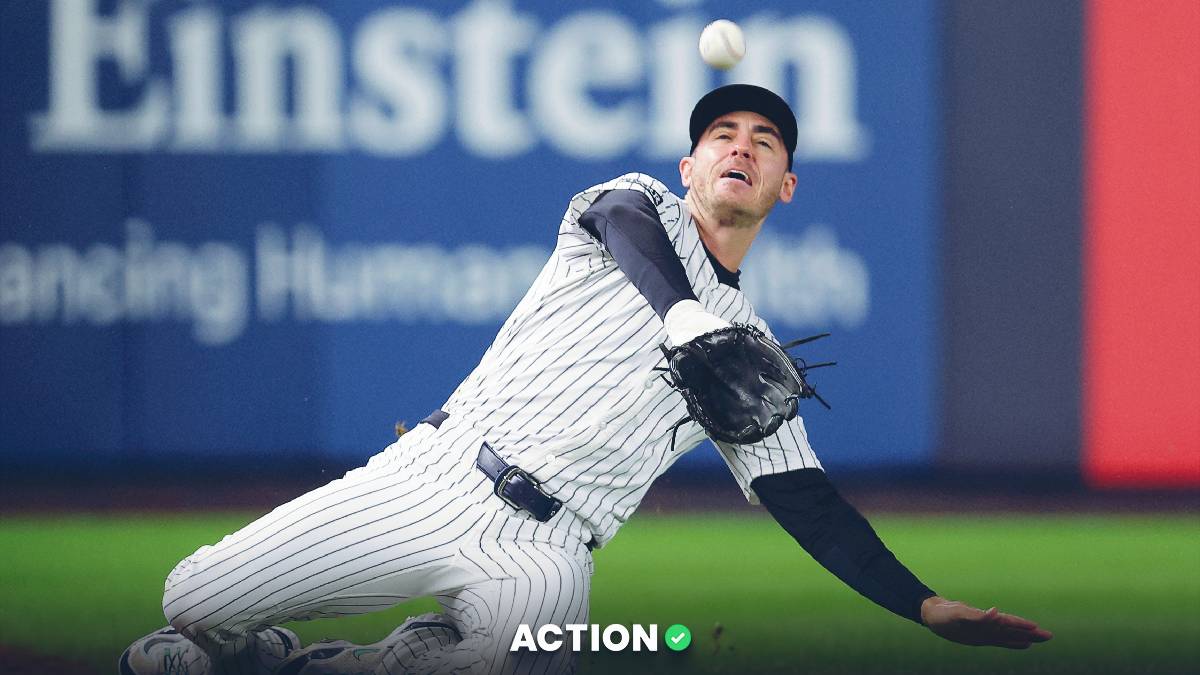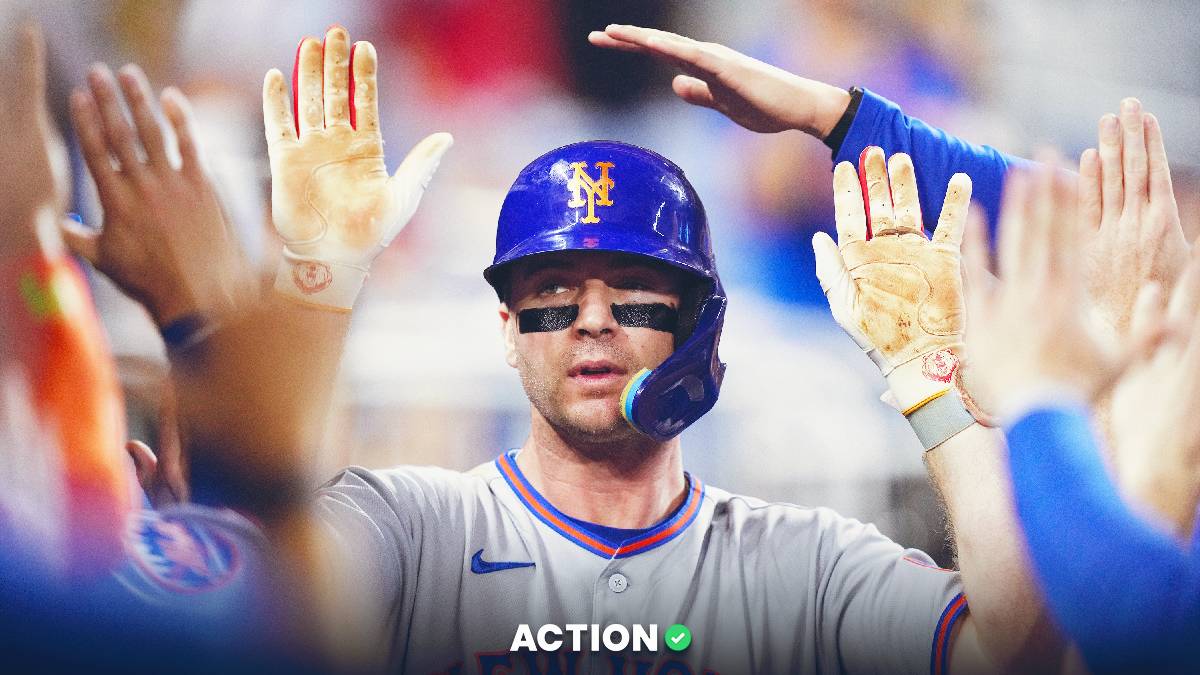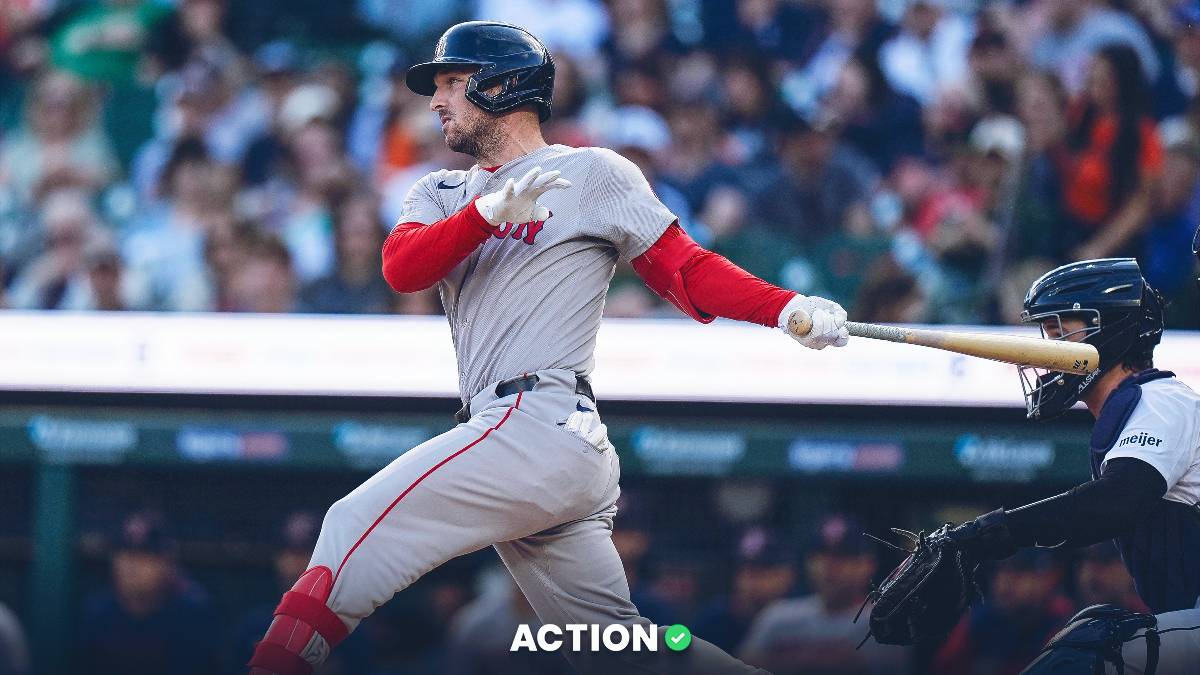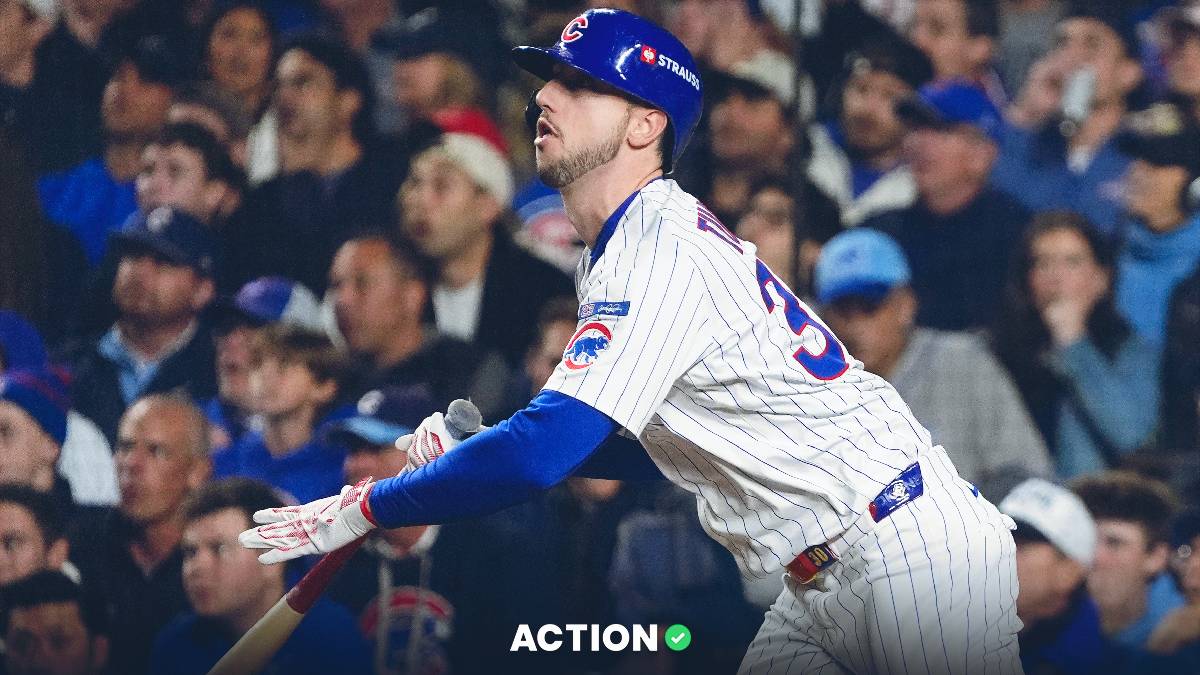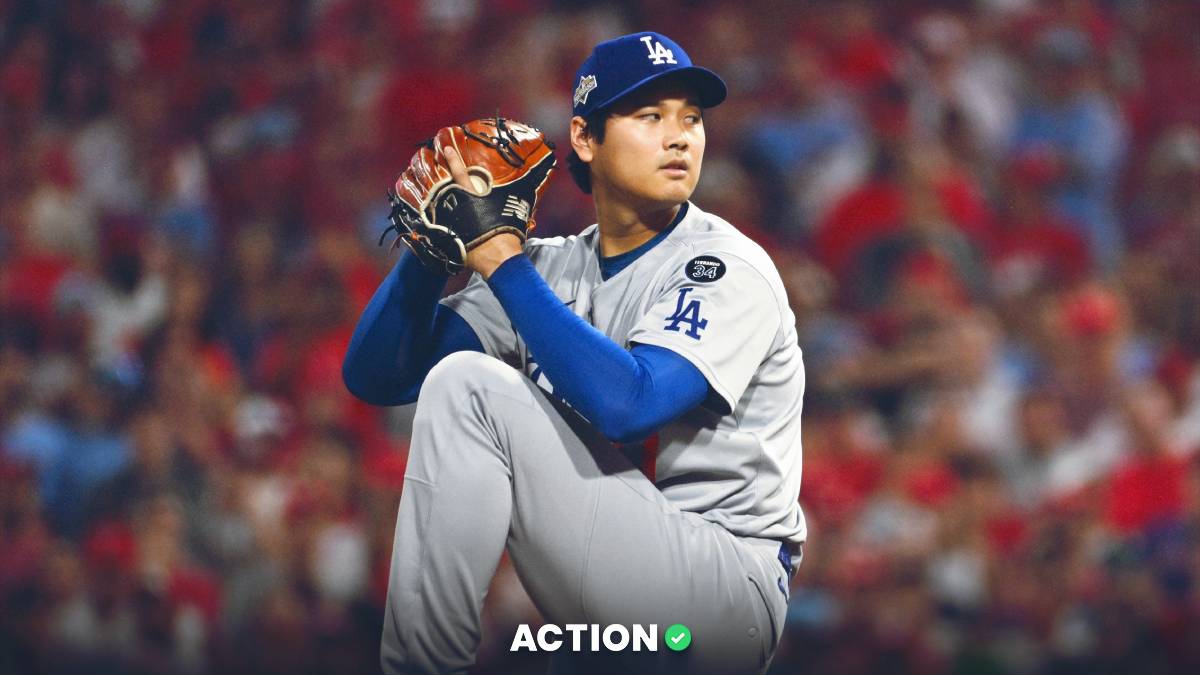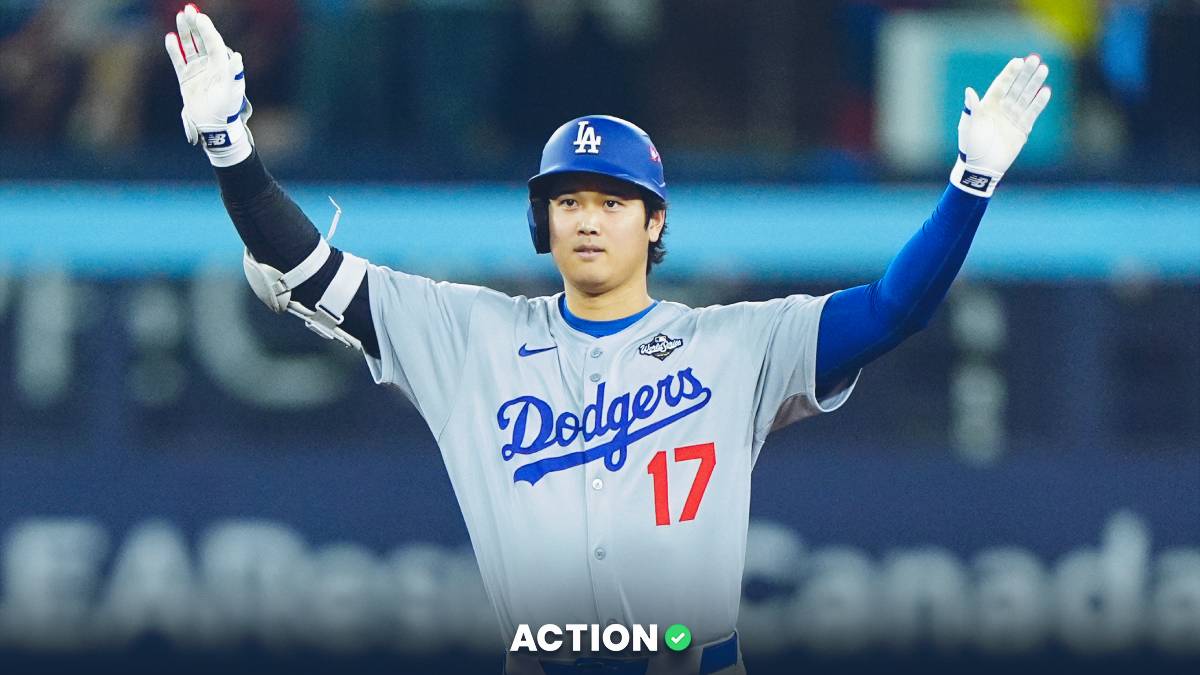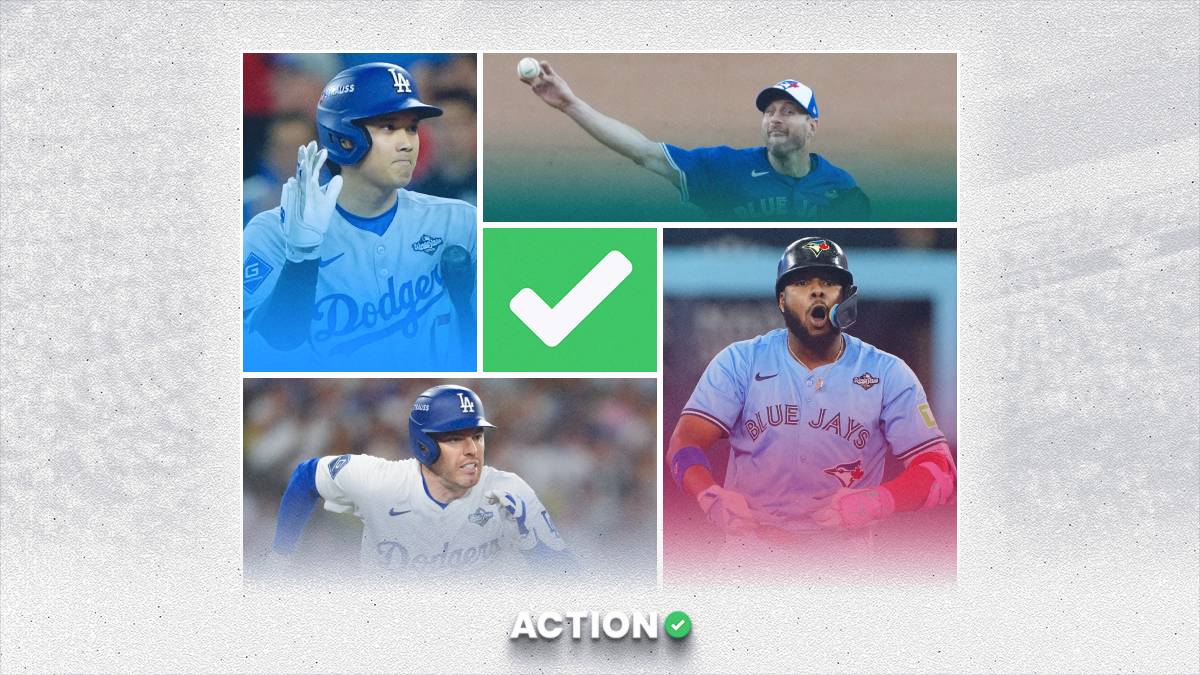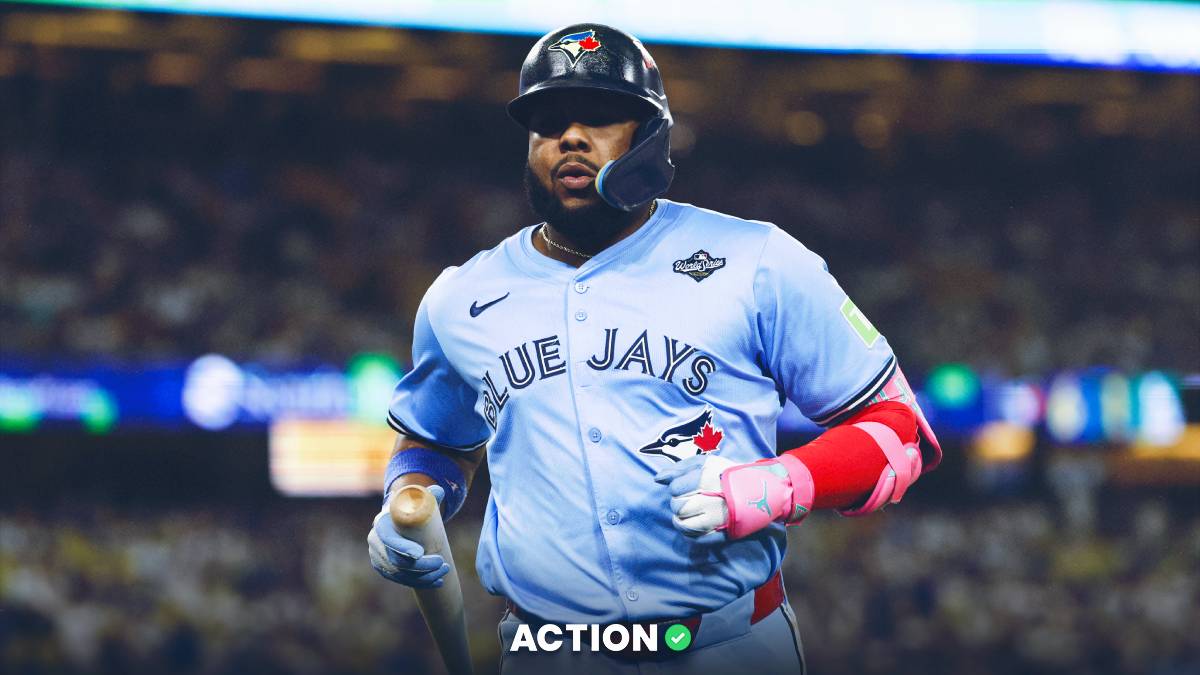Once a week, I’ll be diving deep into some of MLB’s best, worst and most interesting characters. I’ll break down their past, current and projected performance to see if there’s any betting value surrounding that player or his team.
Today, we’re looking at the next great Japanese slugger, Masataka Yoshida.
Make sure to check out past editions of our MLB Player Breakdown series, which include:
Yoshida's Background
Masataka Yoshida did nothing but rake in NPB. He’s a plate-discipline guru who often walked twice as much as he struck out while showing pop, eclipsing 20 home runs in four of his seven seasons.
But Yoshida is small, standing only 5-foot-8 and checking in at 175 pounds. He’s also unproven, as not all NPB players succeed in taking the next step.
So, naturally, there were the Yoshida believers and the Yoshida naysayers.
The believers — especially Chaim Bloom and the Red Sox — focused on his unbelievable plate discipline, control of the strike zone, 70-grade hit tool and ability to create power with an efficient swing (especially against fastballs).
The naysayers focused on his size, perceived lack of power from that size, and limited defensive flexibility.
Either way, Yoshida signed a five-year, $90 million contract to be Boston’s left fielder. Of course, even that signing brought controversy, as most fans were busy complaining about Xander Bogaerts’ West Coast exit.
Yoshida then had a monster WBC, even setting a tournament record for RBIs (13), proving the believers correct that he belonged on the sport’s biggest stage.
He then slumped drastically for the first two weeks of his MLB career, proving the naysayers correct that he would struggle to meet expectations.
Yoshida then ripped off one of the most incredible 16-game stretches ever seen from a rookie, proving the believers right again.
Anyway, he’s currently in the last stage of that development, so it’s worth asking three questions:
- What were Yoshida’s struggles about?
- How has Yoshida broken out?
- How do we project Yoshida and the Red Sox going forward?
Yoshida's Stuff
So, yeah, Yoshida is small. But, at least to my eyes, he swings a monster bat. It sometimes looks like he’s swinging a tree trunk.
Masataka Yoshida flicked a baseball 412 FT with this swing.
4 homers in his first 20 MLB games.
Seems like the power is translating. pic.twitter.com/xVjZEAgZCY
— Tyler Milliken ⚾️ (@tylermilliken_) April 27, 2023
“I knew that (Yoshida) knew how to hit the ball hard, but I didn’t know about the distance,” Red Sox assistant hitting coach Luis Ortiz told The Athletic’s Chad Jennings. “… I told some of the other coaches, if you want to teach how to generate power from a smaller frame, you’ve got to look at this guy.”
His teammates can see it as well.
“You can see the way he’s clearing his hips that there’s power there,” teammate Adam Duvall said to Jennings.
Most Red Sox staff and players identified Yoshida’s power upside from the early scouting process. Most teams loved his contact ability and plate discipline, but many cast him aside as an elite talent because he’s too small to be a slugging outfielder.
Bloom, ever the analytic, decided that Yoshida’s power potential “gave him unique upside in this free-agent market,” writes Jennings.
Yoshida’s average EV isn’t all that high (56th percentile), but his max EV is (84th percentile). He painted a ball 112.3 mph off the bat earlier this season, showing he’s got Major League pop.
The craziest part? He drove it the other way.
Yoshida's hardest hit ball this season (112.3 mph)… quintessential Yoshida hit (a lot of his production has been oppo) pic.twitter.com/Kl8qf1vjVd
— Tanner McGrath (@tannerstruth) May 10, 2023
That is the quintessential Yoshida hit. He went with the low-90s fastball on the outside, letting the ball travel before rocketing it the other way.
It's easy to see why I'm excited about this guy.
Of course, Yoshida’s real attractiveness as a prospect was unbelievable plate discipline. In three NPB seasons between 2020-22, he walked 213 times with only 97 strikeouts, batting .340 with a .440 OBP.
“For us, the thing that really stood out from all angles … is the quality of the at-bat,” Bloom told Jennings. “There's a very unique combination of contact skills and strike-zone discipline and the ability to impact the baseball that we feel has a chance to really impact the game at the Major League level.”
Adam Jones had a good comparison for Yoshida, calling him the “Japanese Juan Soto.”
“He can hit the ball to all fields, all speeds … (he) walks and doesn’t swing outside of the zone.”
Ultimately, Yoshida’s power was (or still is) a mystery. But his ability to avoid strikeouts, control the strike zone and get on base was never in question — he drew two walks to one strikeout across his first four MLB games and has kept his K/BB ratio around 1:1 since.
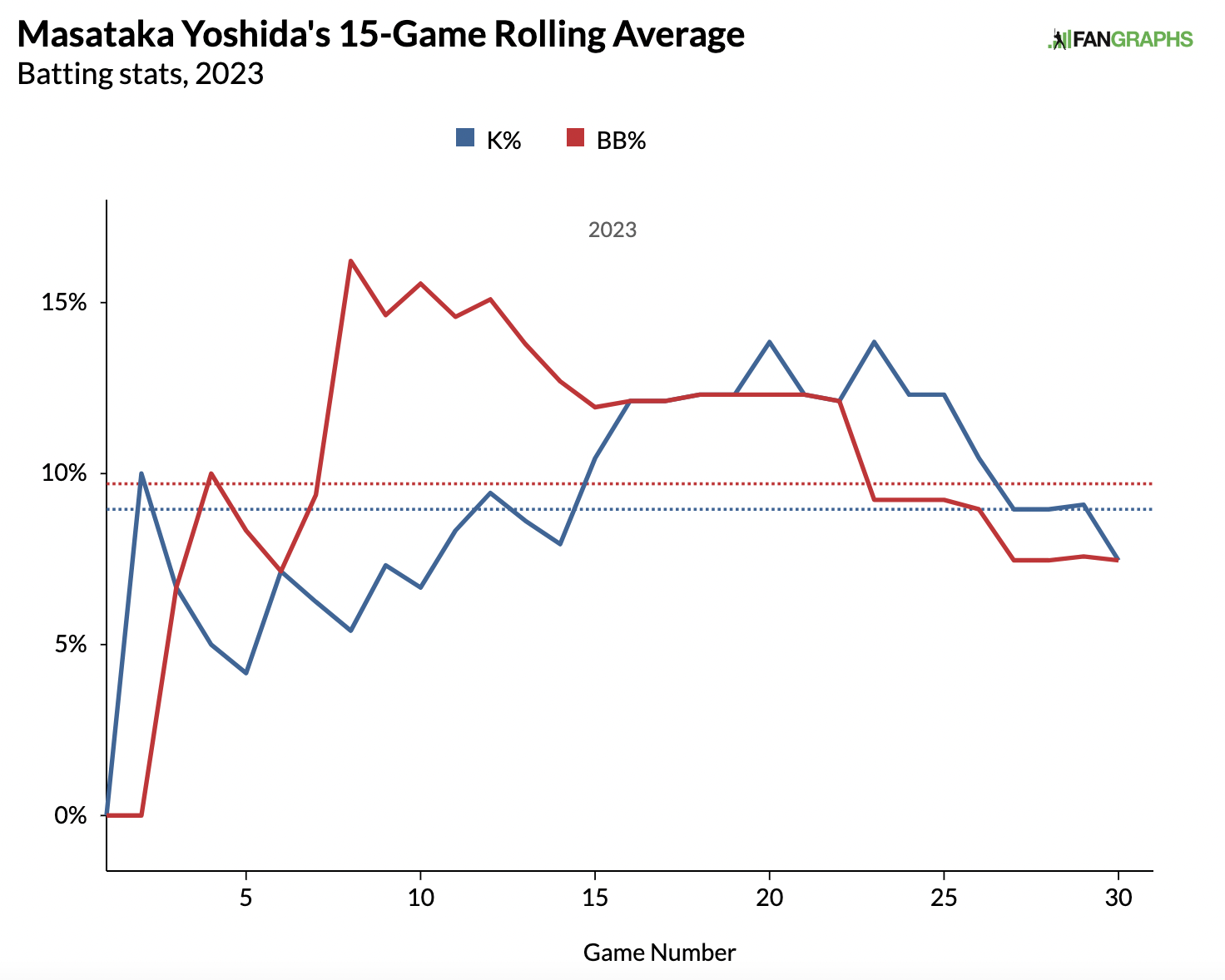 |
However, I have a better comparison for Yoshida than Soto.
The naysayers are probably right about his defensive potential. He can hang tough in the corner but doesn’t grade out as a good defender by any metric.
He generally avoids errors, but he doesn’t get a great jump and isn’t overly athletic. As a result, he’ll never be able to save his team runs in the outfield and will likely cost it runs.
For better or for worse, Yoshida is an outfield slugger. Reminding me of another famous Boston left fielder: Manny Ramirez!
During his seven seasons in Boston, Ramirez posted a 156 wRC+ and -148.1 Defensive Runs Above Average, or -.1506 DRAA per game. In a much smaller sample size, Yoshida has a 155 wRC+ and -4.5 Defensive Runs Above Average, good for -.1551 DRAA per game.
Yoshida probably doesn’t make the same boneheaded plays as Manny, and I'm not ready to compare the Japanese rookie to one of the best right-handed power hitters of all time.
Yet, I just can’t seem to help myself…
Masataka Yoshida doing his best Manny Ramirez. pic.twitter.com/A7vBhcYKqW
— Boston Strong (@BostonStrong_34) May 4, 2023
Recent Results
Yoshida’s first month in the majors is a rollercoaster of epic proportions. It’s not even a rollercoaster but more a halfpipe — a steep descent into a rapid ascent.
But what’s amazing about this halfpipe is a clear, defining midway point where things stop declining and start rising.
 |
Between March 30 and April 18, Yoshida slashed .167/.310/.250 across 13 games. He showed elite plate discipline but wasn’t making any quality contact, recording one home run, one barrel and a -5.1-degree average LA during the stretch.
Yoshida was especially brutal against breaking and offspeed pitches. Baseball Savant tracked 19 Yoshida ABs that ended with an offspeed or breaking pitch, and he recorded only one hit.
Some Statcast metrics from those ABs:
- .172 xBA
- .229 xSLG
- .222 xwOBA
- -5.1-degree average LA
Yoshida once spoke about struggling to adjust to the shorter arm action of Major League pitchers. Longer deliveries are common in Japan, so his timing was thrown off in Spring Training, and ultimately, during his first few weeks in the league.
And this is where things get crazy.
On advice from the Red Sox coaching staff, Yoshida decided to open up his batting stance. It’s a slight adjustment, involving (maybe) a slight drop in his hands but zero changes in his naturally smooth swing.
Yoshida 2 more hits with exit velos of 109, 103, 100, 94, 93 tonight.
DeRosa did a good job breaking down his slight adjustments on MLBN today. pic.twitter.com/AVrqkP4Pwa
— Red Sox Stats (@redsoxstats) May 4, 2023
Before this change, Yoshida couldn’t see breaking and offspeed pitches, especially when adjusting his timing to Major League deliveries. He couldn’t identify and track the spinners, so he would weakly drive them into the ground.
After the change, as told by Yoshida to MLB.com’s Ian Browne:
“I can pick out the balls that I should swing at, so I think that’s why I’m doing well. Stance-wise, I’m stepping with my right foot back a little bit, and it makes me more comfortable to see the ball.”
That was all it took. He opened up his stance and could see better. It's like when you first get glasses.
Yoshida has played 16 games since April 20 and is on a 16-game hitting streak. He’s slashing .438/.479/.750 with five home runs, a 5.9-degree average LA and a 12.8% barrel rate. He’s consistently making hard contact while hitting the ball in the air, and it’s all because he can see the baseball.
And, of course, the breaking/offspeed numbers have skyrocketed. His Savant numbers against breaking and off-speed pitches since April 20:
- .409 BA
- .404 xBA
- .818 SLG
- .857 xSLG
- .521 wOBA
- .532 xwOBA
- 11.1-degree average LA
The differences are astounding. All it took was an off day in late April (if Yoshida pans out, April 19 should become a Massachusetts state holiday).
Surprisingly, Yoshida never faltered against fastballs. The Red Sox scouting department was confident that Yoshida could handle a Major League fastball after seeing how he performed against the hardest-throwing NPB pitchers (95-96 mph), and they were right.
And unsurprisingly, Yoshida’s plate discipline and bat-to-ball skills have never fallen off.
It's all Yoshida all the time lately, but some of this stuff is just insane, such as
Last 10 games: 44 plate appearances, 2 strikeouts, 4 swing and misses, and has only swung at 3 of 40 chase or waste pitches. He last swung and missed on a pitch in the strike zone 9 days ago.
— Red Sox Stats (@redsoxstats) May 5, 2023
Yoshida now has a 10.1% walk rate to an 8.5% strikeout rate.
His ability to make contact with everything is equally as impressive. He’s not Luis Arraez, but he boasts a contact rate of around 83.5%.
Two things stand out about Yoshida’s contact:
- First, his ability to make contact outside the zone. Yes, he rarely chases, but he ranks top-15 among qualified hitters in O-Contact rate at 77%.
- Secondly, he can spray the field. Check out his current spray chart:
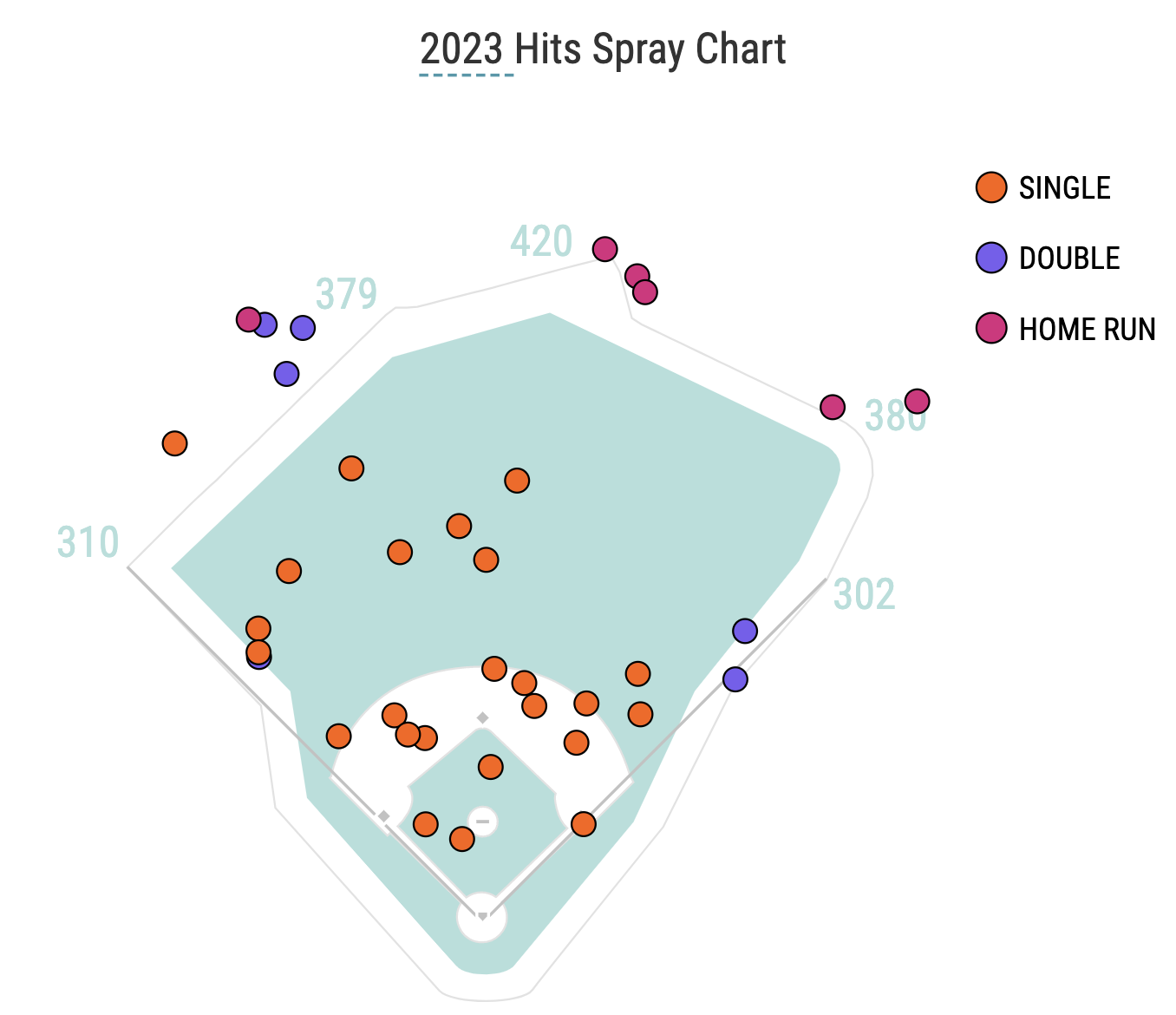 |
You’d have to imagine Yoshida will pull a few more balls going forward, but it’s impressive he can smack it wherever (for example, the hit I posted earlier in this article).
Yoshida's Future Projections
Steamer is the most optimistic, projecting Yoshida for a 141 wRC+ and 2.8 fWAR by the end of his rookie year.
Of course, everyone has him hitting around .300 and walking more than he strikes out. So, his OBP spread is .377-.396, which seems about right.
It’s fair to expect some regression. Yoshida’s BABIP sits at .426 during this 16-game hot streak, and that’ll come down.
I also doubt he’ll ever play anything better than slightly below-average defense. He never gets a solid jump on anything and rarely makes anything other than routine plays. He’s in the first percentile in Outfield Jump and in the 12th percentile in Outs Above Average, but at least he only has one error.
I’m trying to control my excitement, but Yoshida’s breakout feels legit. Sure, he might not be the best hitter in baseball, but his batted-ball profile is immaculate, his plate discipline is consistent, and his hit tool is as advertised.
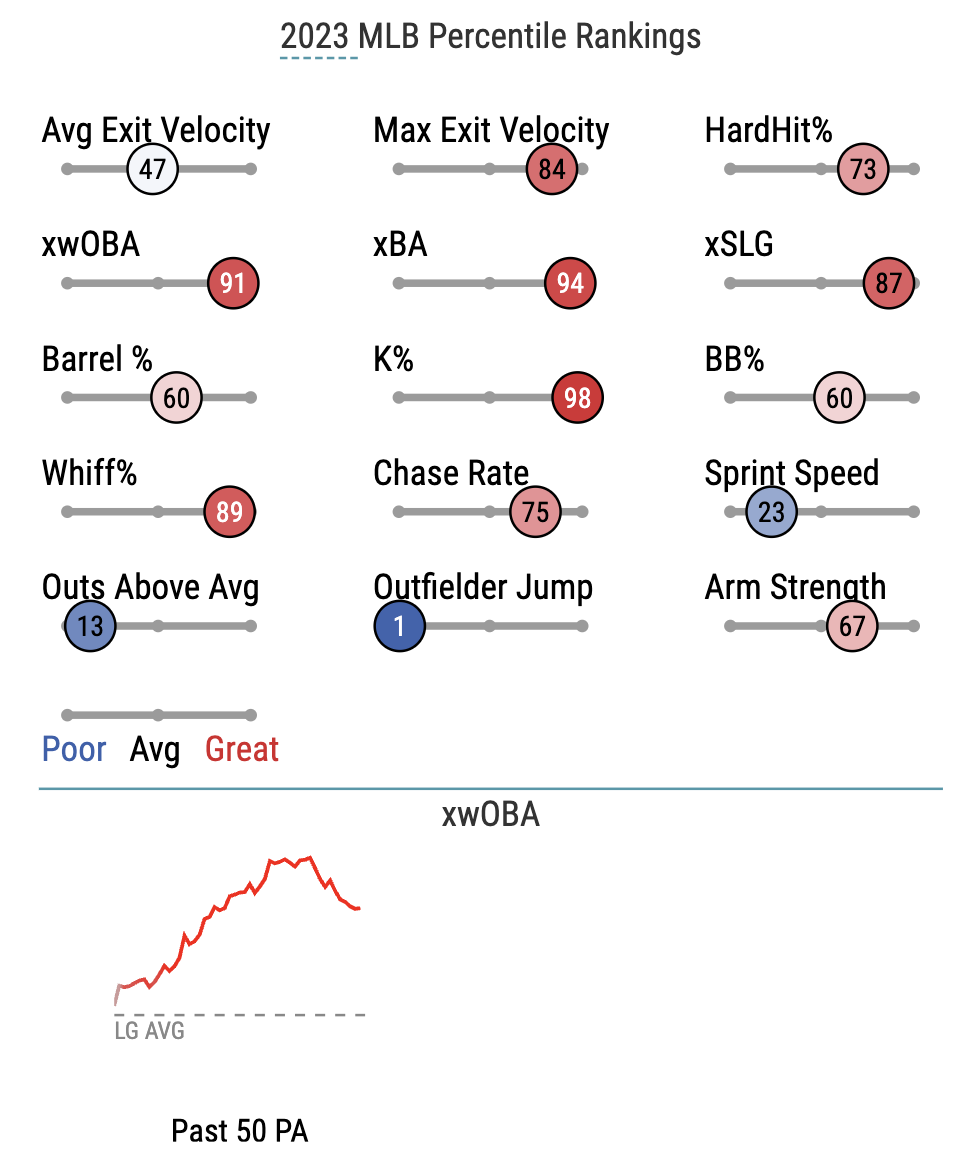 |
Yoshida could post 130 wRC+ or better seasons for years to come. It might be fair to expect some regression in his batting average and power numbers, but he profiles as a super high-floor hitter — he’ll always get on base.
Betting Value on Yoshida
Yoshida is currently a +125 betting favorite at FanDuel to win AL Rookie of the Year. Given his high floor and potential consistent production, I’m not sure he’ll be overtaken by any other rookie (unless he goes through a tremendously poor slump again).
Pick: Yoshida AL Rookie of the Year (+125) |
In terms of actionable advice, I’d like to introduce a trend worth following.
The Red Sox offense has been unstoppable behind Yoshida’s breakout. Meanwhile, the Sox rotation has been the shakiest in baseball, ranking third-to-last in starting pitching ERA.
So, what do you think happened?
Since the infamous April 20 game against Milwaukee, the Red Sox are 12-5-1 to the over. They combined with the Braves for 12 runs last night.
You can usually bank on regression in these instances, but I’m unsure when it comes to Red Sox overs.
Boston is eclipsing their listed totals by more than two runs per game (2.08, to be exact). They're smashing any listed total by a preposterous margin.
The books might have to start giving Boston to the Coors Field treatment at this point — we might see an o12.5 (-110) for a Jays-Sox game at Fenway any day now.
I don’t think this is a fluke, given the Red Sox have the league’s highest OPS (.851) and second-highest wRC+ (130) since April 20 while simultaneously ranking bottom-10 in wOBA allowed.
So, riding Red Sox overs might be wise in the short term, especially with one of the hottest hitters in baseball at the heart of the lineup.
But be cautious, as bookmakers will eventually adjust, the Red Sox BABIP will see some regression (.345 during the hot streak), and the rotation should get slightly luckier (4.42 xFIP).






